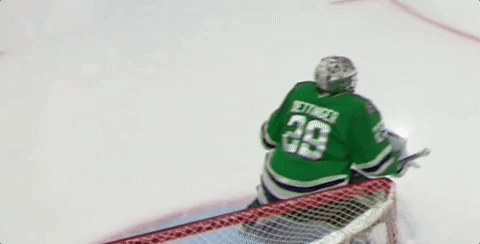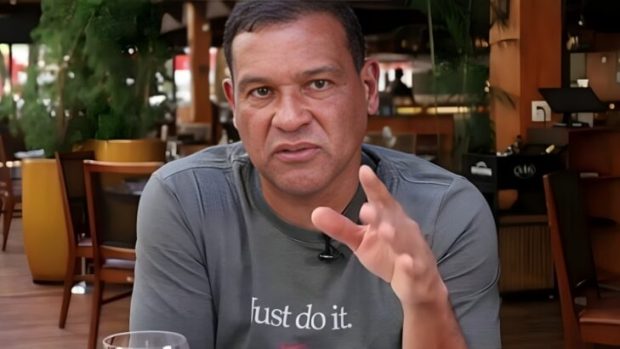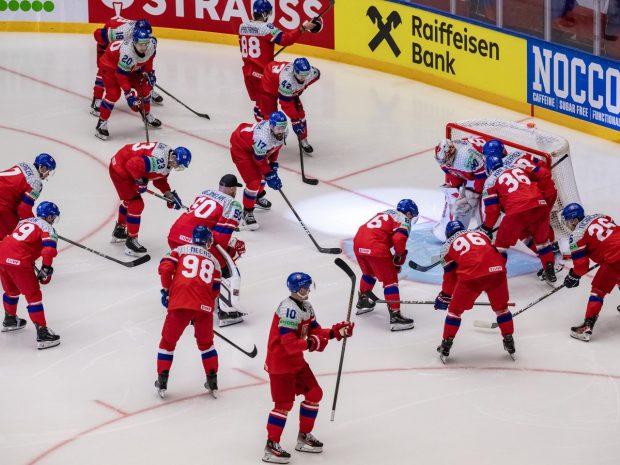In the NHL playoffs, margins are thin. That’s even more true for goaltending, as millimeters and milliseconds are the difference between saves and goals – and as a result, wins and loses.
When the margins are that slim, details are paramount. In a postseason in which offenses have clearly had the upper hand and the league average save percentage was only .898 entering Sunday, only the goalies with the best details in their game have succeeded.
Advertisement
Even the best in the world, playing for the highest stakes, owe much of their success to their commitment to certain basic fundamentals that are engrained early on in a goalie’s career. Maintaining those strong core principals in their stance and playing habits becomes more difficult – but more rewarding – when the play around them gets faster and more intense.
Welcome back to Goalie Tracking, where we examine the details of goaltending and attempt to explain why goalies do what they do. We try to highlight exactly what different goalies are doing to separate themselves. In this special playoff edition, we’re going to look at one goalie from each conference who has done just that.
In Carolina, Frederik Andersen leads all major goaltending statistics in the playoffs. His .937 save percentage and 14.96 goals saved above expected are in a different stratosphere from his competition. In Dallas, Jake Oettinger has backstopped the Stars to the Western Conference final for a third consecutive season.
Let’s begin with Andersen, who has allowed no more than one goal in six of his nine starts in these playoffs, and has given up three goals only once. Part of that is playing for the Hurricanes, who dominate possession and shot volume more than any team in the NHL, but if you dig into Andersen’s individual metrics, it’s clear he’s been special as well.
Of all the stats he leads in, the most impressive is his .923 save percentage on high-danger shots. The league average on those shots (within 29 feet of the net in the slot) is only .810, and the second-highest save percentage by a goalie who played in the second round was Washington’s Logan Thompson at only .857. The gap between Andersen and the rest is massive.
What has been the key to Andersen’s dominance on these difficult shots? What stands out more than anything is his patience on his edges. He waits shooters out, never guessing or making the first move. Instead, he stays on his feet until the last possible moment, which gives him mobility as he reacts to the shot.
This chance by Washington’s Matt Roy in the first period of Game 1 is a good example. Most goalies would’ve butterflied the moment Roy caught the puck, but Andersen held his edges until after Roy released the backhand shot.
Once a goalie drops into butterfly, his lateral mobility is compromised, so holding one’s feet as long as possible is always an advantage. The challenge is, the closer the puck gets to the net, the harder it becomes to resist dropping early to protect against five-hole shots.
This save Andersen made on Washington’s Tom Wilson in Game 2 was technical perfection. I’d say put the replay of this save in the Louvre, but would settle for showing it on repeat to every aspiring young goalie.
Carolina lost Wilson all alone in front of the net, but Andersen was on top of this play the entire way. He stepped out to challenge the shot, staying perfectly square to the puck because he led with his head and stick blade.
Andersen’s stick discipline is one of the biggest keys to his ability to hold his edges longer than most. It may sound simple, but keeping your stick on the ice and leading every movement with it can save a goalie so many five-hole goals against, and Andersen is a master of it.
Advertisement
Many goalies would’ve butterfly slid in this situation and opened themselves up to a deke back against the grain. Wilson quickly realized Andersen was still on his skates and tried to shoot five-hole, but was denied by the stick paddle. Even if Wilson had shot lower, Andersen had it covered with great stick placement.
Here’s another example of Andersen’s stick discipline saving him on a high-danger shot from right in front of the net. This one was against New Jersey Devils winger Nathan Bastian in the first round.
Andersen follows the puck with his stick blade so efficiently, sometimes it looks like it’s being pulled by a magnetic force. It’s impressive to watch, and it’s one of his best weapons on these shots from in tight. He has stopped an incredible 48 of the 52 shots from in close in these playoffs. Over the last four years (since the NHL started its puck-tracking metrics), only one goalie has posted a save percentage above .900 on high-danger shots, and Anderson is well clear of that.
Just for fun, here he is robbing Wilson with his stick positioning yet again – this time on a breakaway in the opening minutes of Andersen’s Game 3 shutout.
Meanwhile, in the West, Oettinger has been a cool customer.
On the ice, he’s as calm of a goalie as you’ll find. His exceptional play-reading ability keeps him ahead of the play, allowing him to maximize his size and make saves look easy.
Composure is in his nature. Off the ice, Oettinger is so easygoing that, speaking to him after a game, you almost can’t even tell he just finished playing. He’s as calm after a thrilling overtime battle in the playoffs as he is following a casual practice skate in the middle of the season. That demeanor is one of the reasons he’s had so much NHL success – with 149 regular-season wins and 31 more in the playoffs – at only 26 years old.
Advertisement
He’s been stellar in these playoffs, trailing only Andersen in save percentage (.919) and GSAx (10.39), and he’s done it with a much heavier workload. Oettinger has made nearly 100 more saves than the next-busiest goalie in these playoffs, and he’s faced two of the top offenses from the regular season in Colorado and Winnipeg.
2025 Playoff Save Leaders
When the puck is in his zone, Oettinger is constantly building a mental image of where every attacking player is on the ice in order to help predict where shots will come from. In this clip, you can see him going through that process with several shoulder checks while the puck is in the corner.
Oettinger is so efficient with his movements. He doesn’t waste any time, taking every moment the puck isn’t in a threatening position to scan the ice. On this particular play, early in Game 4, he scans and identifies Jets forward Gabriel Vilardi skating into the right circle.
These looks are about collecting vital information to help him react as quickly as possible when the pass eventually happens. He knows Vilardi is right-handed, which gives him a much more dangerous shooting angle in this situation. He also knows Vilardi is coming at him with a head of steam, so exploding off his post and getting depth quickly is vital.
Oettinger gets to his spot quickly and confidently because he was thinking ahead of the play. If Vilardi had been a left-handed shooter, Oettinger would’ve needed to get to a very different spot at the top of his crease to remain square (shown by the blue line on the graphic below).

The only way to be perfect on these low-to-high plays is to stay ahead of the play with smart reads. Watch Oettinger’s head whenever the puck goes below the goal line. He uses every opportunity to learn more about what’s happening in front of the net.
Another fundamental that Oettinger does exceptionally well is taking smart routes around his crease. When an east-west pass is made across the zone, he prioritizes getting on angle first, then tries to gain as much depth as he needs, as opposed to immediately jumping out for depth and then chasing the angle. It’s a small detail, but can make a big difference on lateral plays.
Advertisement
Oettinger is also great at getting his feet set before a shot comes. On plays with a long, lateral pass leading up to a dangerous shot, goalies can sometimes get caught drifting toward the shooter when they release the puck. It’s usually because the goalie is trying to get as much depth as possible, but it’s often better to sacrifice an inch or two of depth in order to set your feet.
The difference in difficulty of tracking a puck when your feet are set compared to when they aren’t is night and day. Oettinger does a great job of it on this shot by Winnipeg defenseman Josh Morrissey in Game 3.
Oettinger sees the pass into the slot and knows a shot will be coming fast, but look at how controlled his push out to the top of his crease is. He isn’t sliding out with reckless abandon, trying to get as close to the puck as possible. He pushes out, and collects his feet squarely underneath him to prepare for the shot, and makes a confident blocker save.
Here’s another play in which Oettinger shows the poise to set his feet before the shot, and an understanding of the situation – and how to use it to his advantage. Winnipeg winger Nino Niederreiter is charging toward the net on a partial breakaway in the final seconds of the second period in Game 5, and Oettinger makes what looks like a routine save because of his hockey IQ.
Oettinger realizes Niederreiter has Dallas defenseman Miro Heiskanen draped all over his back, which means two key things for the goalie:
1. Heiskanen’s back pressure from Niederreiter’s right means deking won’t be an option on this play. Neiderreiter will have to shoot the puck. For Oettinger, this means he can take a ton of depth (his heels get well outside of the blue paint) and stand his ground. On a true breakaway, the goalie has to back into his net with the flow of the play to avoid getting deked around, but in this scenario, he doesn’t have to worry about that so he can set his feet.
2. Heiskanen’s desperation stick check can also result in an unpredictable shot. If his stick blade deflects either the puck or Neiderreiter’s stick as he’s releasing, Oettinger won’t be able to read the release, meaning he’s going to have to make this save with positioning and structure.
Advertisement
Understanding all of this, Oettinger gets into perfect position and calmly drops into a tight butterfly, with his stick sealing the five-hole and his hips and shoulders remaining high to cover as much net as possible.
It was a big save and it didn’t look difficult at all. That’s what Oettinger does, and it’s a big reason he didn’t lose a single game in the second-round series against Winnipeg when his team scored at least one goal.
In a postseason with the lowest save percentage we’ve seen in years, Oettinger and Andersen are showing the power of fundamentals.
(Photo of Frederik Andersen: Grant Halverson / Getty Images)
This news was originally published on this post .


















Be the first to leave a comment